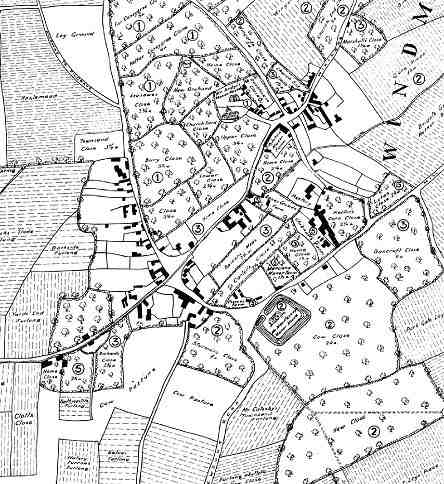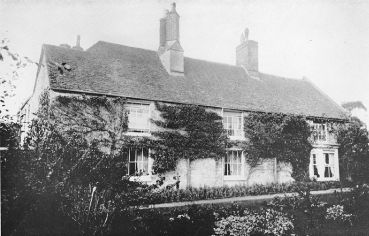From the earliest times much of this part of England was covered with dense forest with isolated rural settlements in the fertile river valleys. Sherington probably followed this pattern, and probably existed as a tiny family hamlet until the West Saxons overran the area in their sweep across the country in Circa A.D. 600. Slowly but surely a typical West Saxon village was established and was originally called 'Sciringtun 'old English for Scira's farm.

No doubt for the next few hundred years the village slumbered on, with the occasional rude awakening from the various Danish invasions , there was continuous fighting in this part of North Bedfordshire, Buckinghamshire between the English and the Danes. We learn in A.D. 1010 that the Danes lay waste the land following the line of the 'Ouse' through to Bedford. On the top of Sherington Hill on the Olney road there's a small field called in medieval times 'Goldhord' where treasures from the village may have been buried to save them from the invaders.
Land in Sherington has had many and varied owners throughout the ages, at the time of the Norman Conquest the powerful Lord of King Edward had a Manor here as did other important followers of the Saxon King. This was soon to change at the coming of the Normans, and no doubt during the conquest Sherington in common with many other villages in the path of the Norman invaders were all but devastated as the Normans would have ranged far and wide to gather in corn and to slaughter livestock for food. The Saxon Lords were divested of their holdings in Sherington and the Bishop of Coutances was given the whole of the village by King William the Conqueror. However, the holding of land during the middle ages became very complicated as successive Kings and the more powerful Nobleman tended to carve up the villages and give away holdings of land for various favours. Landlords following the Conquest were inevitably of Norman origin, such as Robert de Carun. Land was also held by the various ecclesiastical centres, such as Tickford Priory near Newport Pagnell, and the Delapre Abbey near Northampton. Another family who was very involved with ownership of land in the village were the De Caves and the Fitzjohns . Note Caves Manor and Caves End. Many De Caves recorded in Chicheley Church. Of course during all this change of ownership the actual farming of the lands was carried out by the peasants who occupied their cottages and hovels under sufferance to the owners, there was a small number of smallholdings farmed by owner occupiers.
The Black Death took toll of many of the peasants and the smallholders and this period once more saw considerable changes in ownership as certain of the larger landowners acquired land that had become untenable through shortage of labour. Two notable names were 'Chibnall' and Grendon and this has been noted that due to lack of labour much land was left untilled and was let for as little as 2d an acre. About this time one son of a local peasant farming family named John Mathew went to London to seek his fortune and became a Mercer and in fact became Lord Mayor of London in 1490. In the mid sixteen hundreds during a period of much Religious conflict a Society of friends was organised in the village, and they met in a 'Plowright's Cottage' in Water Lane. These people were much persecuted by Local Magistrates heavily fined and in some cases had property confiscated, for non payment of dues to the Church, and for their open views on Religion and the Establishment. However, the Toleration Act of 1686 eased pressure and the cottage became registered as an official meeting place and a nearby field a Quaker Burial Ground. Rumoured to be somewhere to the rear of the property.
During the Civil War the Bridge at Sherington on the Bedford Road became very important due to its position for the garrison at Newport Pagnell. Gun Lane, the road to the east of the Church running to the top of Emberton Hill derived its name from the troop movements in the area. It is rumoured that there was a gun emplacement in the adjacent field. And indeed a cannon ball and musket balls have been found there. Troops were quartered in Sherington, and undoubtedly much farm stock, hay, and corn was requisitioned from the local populce. General Fairfax's Army held a Counsel in Bancroft Field the day before Naseby', in June 1645. During the Civil War there was much divided loyalty among local gentry, and although the people of Sherington were made to pay the heavy monthly contributions of £4 2s 6d to the King in support of his army they were luckier than many villages as but for a short time the area was under the control of the King, and therefore the village did not have to pay taxes first to one side and then the other. While it may have been an exciting interlude for Sherington folk for soldiers to be quartered in the village the decisive Battle of Naseby ended fighting in the area and the company of troops under Captain Ennis who stayed at Sherington was then sent to service in Ireland in the following year.

The Mercer's Company has had a close connection with the village since the reign of Henry VIIth. By and large they proved to be good Landlords. The agricultural revolution' touched Sherington as it did the whole of rural England during the eighteenth. and nineteenth centuries, and an awareness of the necessity for good farming husbandry came none too soon.
It is recorded that the unselfish farmers and smallholders of the area used to allow poor people without land to tether a cow or two per family in the river meadows which soon became overstocked causing the village economy to suffer and it was necessary to legislate to restrict the number of animals kept. The Enclosure Acts of the late eighteenth century caused a further sharp alteration in the ownership of land of the village. The rearrangement of fields through the fencing of common lands, although it made for more efficient farming it reduced, the demand for labour and redundant farm workers had to be subsidised from the Parish Rates. Unhappily the National Economy was also under some strain through the war with France, and it is very sad to read in the records that a great number of smallholders and owners of cottages had to sell their property, and move away. For many generations the womenfolk of the smallholders and labourers had subsidised the meagre family means by lace making and rush mat making and basket making for dealers in Newport Pagnell and Olney and even these cottage industries were affected by the general economy. But the cottage industries carried on right up until the beginning of the 20th C
Up to the present day farmland and houses have continued to change hands, and for the smaller farms to be amalgamated with the larger holdings, and the farmhouses tending to become private houses'. One of the biggest changes was in 1919 when the Mercer's Company finally sold their land to their tenants bringing to a close over 400 years their association with the village. No doubt the next greatest change in the appearance of the village was the new by-pass and we now know that it is finally constructed and we hear no more the pounding of heavy lorries through our Main Street and see the queues of cars through the village from the Olney Road we may once more slumber back in time.
This is one of two brief histories of Sherington as seen through the eyes of two senior residents of the village, Philip Smith and Sidney F Morgan, available on the web site after transcription by Norman Arnold. For a much fuller and in depth history of the village, the book written by Professor Chibnall 'Sherington - Fiefs and Fields of a Buckinghamshire Village', will answer all or most questions that the reader would wish to ask. Also the complementary book by the same author 'Beyond Sherington', gives an insight into the growth of the Sherington Parish.